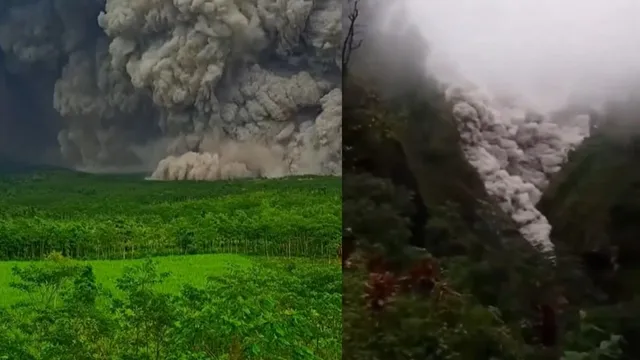- By Shivangi Sharma
- Thu, 20 Nov 2025 10:39 AM (IST)
- Source:JND
Indonesia’s Mount Semeru, the tallest peak on Java island, erupted on Wednesday with extraordinary force, sending volcanic ash soaring up to 13 km into the sky and unleashing massive pyroclastic flows that raced down its slopes. Dramatic videos of the eruption quickly went viral, showing towering ash clouds engulfing villages, darkening skies and triggering panic among residents.
Authorities immediately raised the alert status to its highest level, urging people to stay away from designated danger zones as ash continued drifting across East Java. The eruption sent columns of smoke and ash as tall as 2 km above the summit, while thick gray clouds swept across the countryside, swallowing a bridge and halting locals in shock.
Pyroclastic Flow Travels 7 km From Crater
CCTV footage captured one of the eruption’s most dangerous phenomena, a 7 km-long pyroclastic flow, a deadly, fast-moving avalanche of scorching ash, gas and volcanic debris. Indonesia’s volcanology agency also released videos showing dense ash clouds cascading down Semeru’s slopes, coating everything in their path.
Officials reported no casualties so far, according to the Associated Press. However, the eruption forced over 300 residents from three high-risk villages in Lumajang district to evacuate to government shelters. Videos shared online showed residents running toward safety, some covered in volcanic ash mixed with rain, while others were seen navigating ash-choked roads under a darkened sky.
178 Climbers Stranded But Safe, Say Officials
A major rescue operation was launched after reports emerged that around 178 people were stranded on the 3,676-meter mountain near the RanuKumbolo monitoring post. The group included 137 climbers, 15 porters, seven guides and six tourism officials.
“All climbers with their guides are safe… The situation is under control,” said SeptiWardhani of Semeru National Park. Officials confirmed the stranded group was sheltering at a post 4.5 km from the crater on the northern slope, an area safely away from the pyroclastic flow path. Bad weather and heavy rain had forced the climbers to remain at a lakeside campsite 6.4 km from the crater.
ALSO READ: ‘From Red Fort to Kashmir’: Pakistan Leader Publicly Admits Role In Terror Attacks Across India

